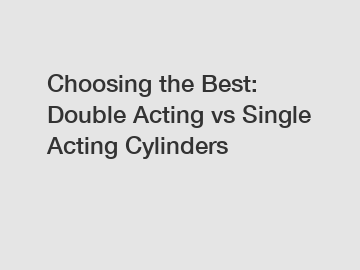Choosing the Best: Double Acting vs Single Acting Cylinders
Cylinders form an essential component in various industrial and mechanical applications, serving as actuators that generate linear force and motion. When it comes to selecting the right cylinder for a specific task, it's crucial to consider factors such as efficiency, reliability, and cost-effectiveness. In this blog, we will explore the differences between two common types of cylinders: double acting and single acting. By understanding the unique characteristics of each, you can make an informed decision based on your specific requirements.
Double Acting Cylinders: Efficiency at Its Peak.
Double acting cylinders are designed to provide force in both directions of operation. This versatility enables enhanced efficiency, especially in applications where both retraction and extension forces are crucial. They consist of two ports, one for extending the piston rod and the other for retracting it. This design allows for smooth and controlled movement, making them ideal for applications that require precision and speed.

One of the standout advantages of double acting cylinders is their ability to generate equal force in both directions of travel. This balanced force distribution allows for optimal control over positioning, making them ideal for tasks that demand high degrees of accuracy. From automobile manufacturing to robotics, these cylinders find applications in various industries where efficiency and precision are paramount.
Single Acting Cylinders: Simplicity and Cost-effectiveness.
With a simpler design compared to their double acting counterparts, single acting cylinders offer a cost-effective solution for applications where force is only necessary in one direction. Unlike double acting cylinders, single acting cylinders have only one port, which is used for supplying the compressed air or fluid to extend the piston rod. The retraction of the piston, on the other hand, is typically accomplished using an external mechanical force or spring.
The simplicity of single acting cylinders makes them suitable for applications that don't require bidirectional force or precise positioning. Industries that commonly utilize single acting cylinders include agriculture, construction, and general machinery. Due to their straightforward design, these cylinders tend to be more affordable and easier to maintain, making them an economical choice for many applications.
Choosing the Right Cylinder for Your Application:
The decision between double acting and single acting cylinders ultimately depends on the specific requirements of your application. Here are some key factors to consider when making your choice:
1. Force and Stroke Requirements: Evaluate whether your application demands equal force in both directions or only in one direction. If bidirectional force and precise positioning are crucial, double acting cylinders are the way to go. On the other hand, if unidirectional force is sufficient, single acting cylinders often provide a more cost-effective solution.
2. Speed and Control: Consider the desired speed and level of control required for your application. Double acting cylinders are better suited for tasks that demand quick and precise movements, allowing for optimal positioning control. Single acting cylinders, while not as versatile, still offer satisfactory performance for applications that don't necessitate complex movements.
3. Budget and Maintenance: Assess your budget and maintenance capacity. Single acting cylinders tend to have a simpler design and lower initial cost. Additionally, the absence of complicated internal components often results in easier maintenance and reduced downtime.
Conclusion:
When deciding between double acting and single acting cylinders, it's crucial to carefully consider the requirements of your specific application. Double acting cylinders excel in precision tasks that demand bidirectional force and control, allowing for optimal positioning. On the other hand, single acting cylinders offer a more straightforward and cost-effective solution for applications that require force in only one direction.
Ultimately, the choice comes down to finding the right balance between optimizing efficiency, cost-effectiveness, and maintenance requirements. By keeping these factors in mind, you can select the ideal cylinder type that aligns with your project goals and budget constraints.
Are you interested in learning more about customized multi stage hydraulic ram supplier, metallurgical cylinder supplier, Wind Tunnel Hydraulic Cylinders Factory? Contact us today to secure an expert consultation!


